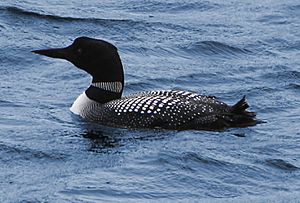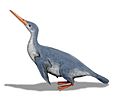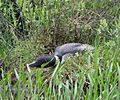Loon facts for kids
A loon is a special bird that loves living on the water. They look a bit like a large duck or a small goose. Loons can be a little tricky to spot because they are shy around people. The word "loon" actually comes from an old Scandinavian word meaning "clumsy," which might seem funny since they are so graceful in the water! The loon is the state bird of Minnesota. You can find loons in many parts of North America and Eastern Europe. They like cool weather in the summer and travel to ocean coasts when winter arrives.
Contents
Built for Diving
Loons are amazing divers! They can dive as deep as 200 feet (about 60 meters) underwater to find their food. Their bodies are perfectly designed for this. Unlike most birds, which have hollow bones, loons have solid bones. This helps them sink easily. Their feet are also placed far back on their bodies, which makes them excellent swimmers underwater.
What Loons Look Like
There are five different kinds of loons found in North America. Most loons have heads that are black or grey, light-colored chests, and backs with cool striped patterns.
Life Cycle and Raising Young
Loon parents usually lay one or two eggs. These eggs are brownish, which helps them blend in with their surroundings and stay hidden from predators. Both the male and female loon take turns sitting on the eggs to keep them warm until they hatch.
Once the young loons hatch, they stay with their parents. When the weather starts to get cold, the family flies south for the winter. Young loons will spend about three years in the warmer southern areas before they fly back north to start their own families.
Loon Sounds and Communication
Loons are famous for their loud, trumpet-like calls. They also make beautiful, wailing, or laughing sounds. These different sounds help loons talk to each other.
Loons also use special "dances" on the water to communicate. For example, they might dance to warn other animals or even humans to stay away from their nests. Loon parents are very protective of their eggs. They will dance and try to scare away dangers like raccoons, gulls, and skunks, which sometimes try to eat loon eggs.
What Loons Eat
Loons mainly eat fish, such as sunfish, perch, and bullheads. They don't chew their food like we do! Instead, loons have very stretchy throats that allow them to swallow fish whole. Their throats can expand to fit the size of the fish they catch, so they don't choke.
Studying Loons
Scientists often "band" or "tag" loons. This means they put a small, harmless band on the loon's leg. By doing this, scientists can learn more about where loons travel, how long they live, and other important facts about these fascinating birds.
Images for kids
-
The Paleocene Waimanu (an early member of the Sphenisciformes) resembled loons in some aspects of its head and bill, but it was already flightless and used its feet for steering rather than propulsion
-
Red-throated loon (G. stellata), the smallest living Gavia species. Some Miocene members of this genus were smaller still.
-
1918 illustration of a variety of loons by Archibald Thorburn. Top: Common loon, Mid-left: red-throated loon, Mid-right: yellow-billed loon, Bottom: black-throated loon
-
Common loon (Gavia immer) rearing up. Note the plump body and pointed but rather short wings
-
Yellow-billed loon (Gavia adamsii) in winter plumage
See also
 In Spanish: Colimbos para niños
In Spanish: Colimbos para niños












